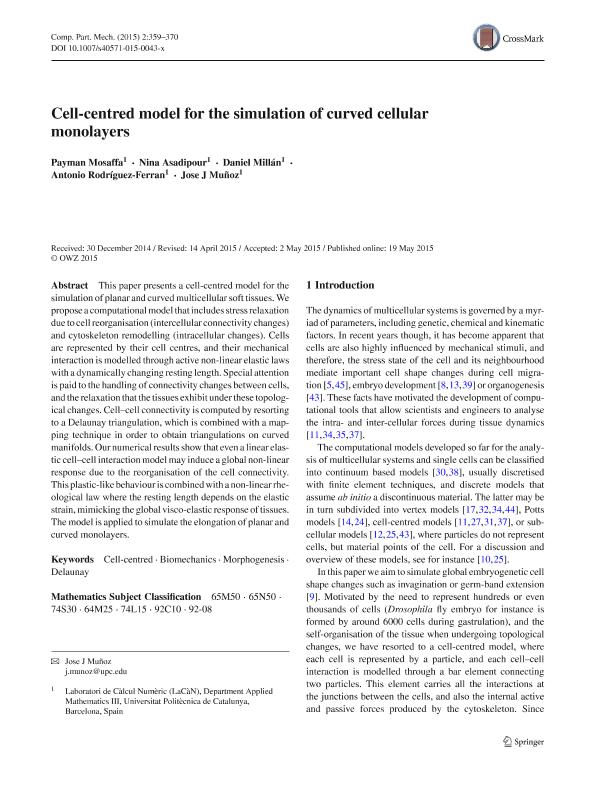Artículo
Cell-centred model for the simulation of curved cellular monolayers
Fecha de publicación:
12/2015
Editorial:
Springer International Publishing
Revista:
Computational Particle Mechanics
ISSN:
2196-4386
e-ISSN:
2196-4378
Idioma:
Inglés
Tipo de recurso:
Artículo publicado
Clasificación temática:
Resumen
This paper presents a cell-centred model for the simulation of planar and curved multicellular soft tissues. We propose a computational model that includes stress relaxation due to cell reorganisation (intercellular connectivity changes) and cytoskeleton remodelling (intracellular changes). Cells are represented by their cell centres, and their mechanical interaction is modelled through active non-linear elastic laws with a dynamically changing resting length. Special attention is paid to the handling of connectivity changes between cells, and the relaxation that the tissues exhibit under these topological changes. Cell–cell connectivity is computed by resorting to a Delaunay triangulation, which is combined with a mapping technique in order to obtain triangulations on curved manifolds. Our numerical results show that even a linear elastic cell–cell interaction model may induce a global non-linear response due to the reorganisation of the cell connectivity. This plastic-like behaviour is combined with a non-linear rheological law where the resting length depends on the elastic strain, mimicking the global visco-elastic response of tissues. The model is applied to simulate the elongation of planar and curved monolayers.
Palabras clave:
Biomechanics
,
Cell-Centred
,
Delaunay
,
Morphogenesis
Archivos asociados
Licencia
Identificadores
Colecciones
Articulos(CCT - MENDOZA)
Articulos de CTRO.CIENTIFICO TECNOL.CONICET - MENDOZA
Articulos de CTRO.CIENTIFICO TECNOL.CONICET - MENDOZA
Citación
Mosaffa, Payman; Asadipour, Nina; Millán, Raúl Daniel; Rodríguez Ferran, Antonio; Muñoz, Jose J; Cell-centred model for the simulation of curved cellular monolayers; Springer International Publishing; Computational Particle Mechanics; 2; 4; 12-2015; 359-370
Compartir
Altmétricas




